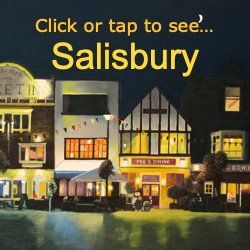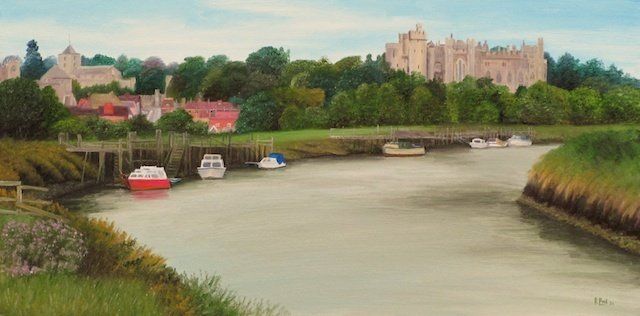South Coast
Tap or click an image to explore, or just scroll for more...
If you travel to Southampton you'll find that much of it is modern with only pockets of buildings that survived the war.
For something a little more pleasing we can follow the river Itchen. Before it reaches Southampton, it is little more than a stream, but it widens greatly through riverside park, and under Cobden bridge. And that is where you can spot these houseboats.

...buy the print from Redbubble.com
Head further down the river Itchen, and for a while there are few places where we can reach the water, but eventually we come to Ocean Village. Thirty years ago it was a vibrant little marina with a two storey mall of quirky shops and cafes that spilled out for views of the marina. There were some desirable houses and flats to be found too. Development has been on turbo since then, so now the water and the original residences are all but crowded out by tower blocks. Its still an interesting place to paint though, and it was fun to try my hand at a skyscraper!

If you find your way to Hamble it might be because you remember an old TV series that featured the place. Its nothing like what you imagined, but there is a little cobbled street that heads down to the shore. And a little promenade to enjoy the views.
There is also a little pink ferry to take you across the river to Warsash and a drink at 'The Rising sun'. A pleasant walk from there follows the river bank up to Bursledon.

Next stop Portsmouth. Walking South from the harbour station you pass through a modern shopping precinct with a tall pointy millenium folly, and eventually reach the more relaxing old town. There is a cathedral (which turns out to be mainly quite new), and then a stop for a drink and maybe a meal at one of the old pubs in this part of town. Looking back towards the historic dockyard and HMS Warrior, you see very little of the modern world.

... buy the print from Redbubble.com
Next you come to the artists galleries in the arches. Above on the wall you get a look back to where you've come from, which somehow sums up the city in one view. And below there is a slither of beach that gets covered by the tide. In this part of the coast there is a double high tide, so its in most of the time.
If you walk the walls and next come to the very 1950s looking Clarence pier. It has to be the shortest you have seen, for it doesn't even reach the sea.

Beyond the Pier you can follow the newly rebuilt sea wall all along the shore, but be sure to stop by for a look at Southsea Common. Its a large green space in an otherwise densely packed little island. If you pick the right date there will be something going on. Today it happens to be the annual kite festival - quite a spectacle, and free to visit...

Follow the shore East and you come to the little ferry across to Hayling Island. Close to where you land there is a ramshackle cafe to enjoy a bit of tea and cake whilst local lads dip in the sea outside and cast their lines in the hope of catching something better than a chill.
You could walk along the beach from here, but if you start along the ferry road instead, you pass chalets and an inlet known as The Kench. At low tide its mud, but you catch it at high tide as a couple of swans paddle the shallows.
Bosham is a fairly pretty place known for the muddy creeks that surround it and the road which is submerged at high tide, stranding many a motorist that foolishly parked there, oh and a distinctive old church too. Find the right footpath along the shore and you may come to this dogrose...

... buy the print from Redbubble.com
Next to Arundel. Until a few years ago getting there from the station involved running the gauntlet of traffic crossing the busy road. Thankfully there is a pedestrian underpass now, but its still a walk along a busy road. So instead of heading direct, turn off down to the river bank and take a rather long walk along the bank to a tiny village near Amberley, cross on the road bridge and then climb up through the woods. This circuitous route leaves you making a grand entrance to the town descending grassy slopes from the North. And all that walking has worked up an appetite for tea and cake - so lets find a coffee shop.
After Arundel the train line heads into suburbia - the long sprawl of joined up coastal towns that leads eventually to Brighton - but must the train stop at every little suburb?
A big leap East now to Hastings. Its all very commercial and modern, and even on reaching the shore there is nothing of note. But with perseverance and many footsteps East you can reach the old town, and eventually the fishing quarter with its distinctive tall fishermans huts preserved for posterity (and the photographers they attract). Behind them, on the beach is a jumble of boats and the rusty tractors used to pull them ashore.
It is possible to walk to Rye from here, but its quite a trek along the coast and then following the start of the old canal (built to keep Napolean out). You are welcome to take the bus instead.
Another big leap East now to Folkestone, exploring the historic harbour, which is now just a ghost of the interesting place it once was. But passing through you find yourself descending a rough path to a beach the tourists don't know about. Its a wild place with a tranquil haven of shrubbery behind, in turn sheltered by the white cliffs. This makes it very quiet despite its proximity to the sprawling town. The railway to Dover cuts along the base of the cliffs, but its largely unseen behind the reinforcements put in place a century ago after one too many landslides. In the distance a slither of land juts from the cliffs - Samphire Hoe - created from the spoil from digging the channel tunnel.

You could walk the cliffs to Dover, but the train journey is not to be missed. So head back to the station, and gaze from the train window as it weaves through the cliffs on one of the most scenic stretches of track in the country.
Dover is a busy port with thundering traffic, so leave quickly by the cliff path beside the port. It climbs below the busy A2 as it shoots out from the cliff. But soon it is quiet, and you have a choice of paths, some perilously close to the cliff edge (on a ledge), and others a bit more comfortable, such as this, where you can look back to Dover Castle.

If you've enjoyed this little journey, why not join me on another. Click or tap a picture below to explore another region...

















